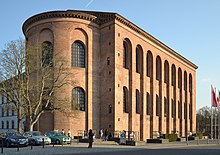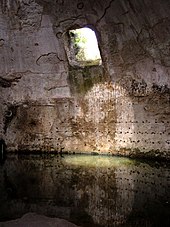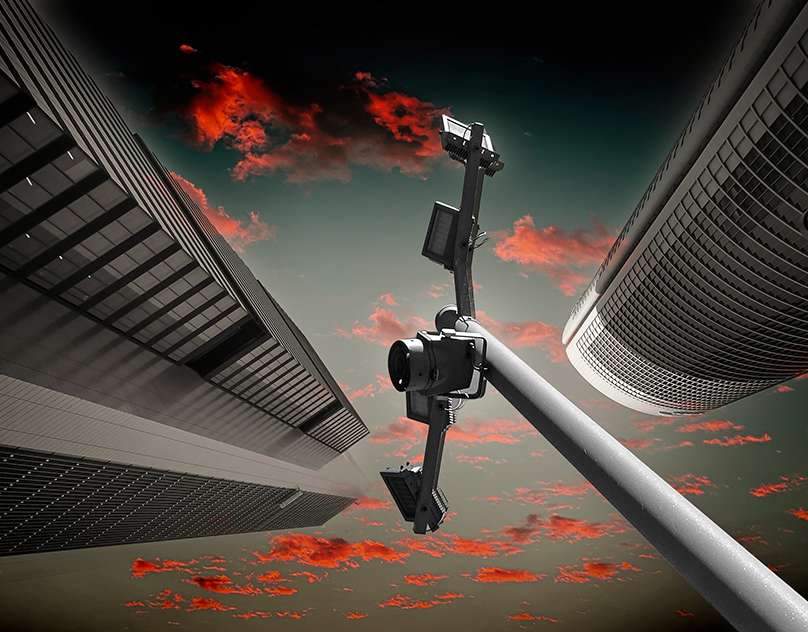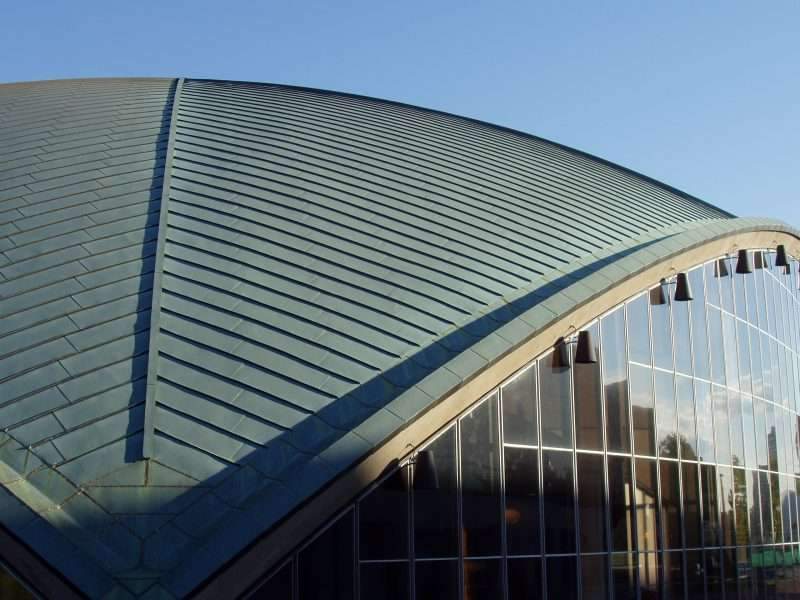Ancient Roman architecture
Historic Roman structure adopted the exterior language of classical Greek structure for the needs of the traditional Romans, however was totally different from Greek buildings, changing into a brand new architectural model. The 2 types are sometimes thought-about one physique of classical structure. Roman structure flourished within the Roman Republic and to even a larger extent beneath the Empire, when the good majority of surviving buildings had been constructed. It used new supplies, notably Roman concrete, and newer applied sciences such because the arch and the dome to make buildings that had been usually sturdy and well-engineered. Massive numbers stay in some kind throughout the previous empire, typically full and nonetheless in use to at the present time.
Roman structure covers the interval from the institution of the Roman Republic in 509 BC to in regards to the 4th century AD, after which it turns into reclassified as Late Vintage or Byzantine structure. Few substantial examples survive from earlier than about 100 BC, and a lot of the main survivals are from the later empire, after about 100 AD. Roman architectural model continued to affect constructing within the former empire for a lot of centuries, and the model utilized in Western Europe starting about 1000 known as Romanesque structure to mirror this dependence on fundamental Roman varieties.
The Romans solely started to attain important originality in structure across the starting of the Imperial interval, after they’d mixed elements of their initially Etruscan structure with others taken from Greece, together with most parts of the model we now name classical structure. They moved from trabeated development principally based mostly on columns and lintels to 1 based mostly on large partitions, punctuated by arches, and later domes, each of which tremendously developed beneath the Romans. The classical orders now turned largely ornamental slightly than structural, besides in colonnades. Stylistic developments included the Tuscan and Composite orders; the primary being a shortened, simplified variant on the Doric order and the Composite being a tall order with the floral ornament of the Corinthian and the scrolls of the Ionic. The interval from roughly 40 BC to about 230 AD noticed a lot of the best achievements, earlier than the Disaster of the Third Century and later troubles lowered the wealth and organizing energy of the central governments.
The Romans produced large public buildings and works of civil engineering, and had been liable for important developments in housing and public hygiene, for instance their private and non-private baths and latrines, under-floor heating within the type of the hypocaust, mica glazing (examples in Ostia Antica), and piped cold and warm water (examples in Pompeii and Ostia).
Overview
Regardless of the technical developments of the Romans, which took their buildings distant from the essential Greek conception the place columns had been wanted to help heavy beams and roofs, they had been very reluctant to desert the classical orders in formal public buildings, though these had grow to be primarily ornamental.[citation needed] Nonetheless, they didn’t really feel completely restricted by Greek aesthetic considerations and handled the orders with appreciable freedom.[citation needed]
Innovation began within the third or 2nd century BC with the event of Roman concrete as a available adjunct to, or substitute for, stone and brick. Extra daring buildings quickly adopted, with nice pillars supporting broad arches and domes. The liberty of concrete additionally impressed the colonnade display screen, a row of purely ornamental columns in entrance of a load-bearing wall. In smaller-scale structure, concrete’s power freed the ground plan from rectangular cells to a extra free-flowing surroundings.
Components resembling wealth and excessive inhabitants densities in cities pressured the traditional Romans to find new architectural options of their very own. The usage of vaults and arches, along with a sound data of constructing supplies, enabled them to attain unprecedented successes within the development of imposing infrastructure for public use. Examples embrace the aqueducts of Rome, the Baths of Diocletian and the Baths of Caracalla, the basilicas and Colosseum. These had been reproduced at a smaller scale in most vital cities and cities within the Empire. Some surviving buildings are nearly full, such because the city partitions of Lugo in Hispania Tarraconensis, now northern Spain. The executive construction and wealth of the Empire made doable very massive tasks even in places distant from the primary facilities,[1] as did using slave labor, each expert and unskilled.
Particularly beneath the empire, structure usually served a political perform, demonstrating the facility of the Roman state usually, and of particular people liable for constructing. Roman structure maybe reached its peak within the reign of Hadrian, whose many achievements embrace rebuilding the Pantheon in its present kind and leaving his mark on the panorama of northern Britain with Hadrian’s Wall.
Origins
Whereas borrowing a lot from the previous Etruscan structure, resembling using hydraulics and the development of arches, Roman status structure remained firmly beneath the spell of Historic Greek structure and the classical orders.[2]
This got here initially from Magna Graecia, the Greek colonies in southern Italy, and not directly from Greek affect on the Etruscans, however after the Roman conquest of Greece instantly from the very best classical and Hellenistic examples within the Greek world.[citation needed]
The affect is clear in some ways; for instance, within the introduction and use of the triclinium in Roman villas as a spot and method of eating. Roman builders employed Greeks in lots of capacities, particularly within the nice growth in development within the early Empire.[citation needed]
Roman architectural revolution

The Roman Pantheon
The Roman architectural revolution, often known as the “concrete revolution”,[3][4][5] was the widespread use in Roman structure of the beforehand little-used architectural types of the arch, vault, and dome. For the primary time in historical past, their potential was absolutely exploited within the development of a variety of civil engineering buildings, public buildings, and navy services. These included amphitheatres, aqueducts, baths, bridges, circuses, dams, domes, harbours, temples, and theatres.
An important issue on this growth, which noticed a pattern towards monumental structure, was the invention of Roman concrete (opus caementicium), which led to the liberation of shapes from the dictates of the normal supplies of stone and brick.[6]
These enabled the constructing of the numerous aqueducts all through the Roman Empire, such because the Aqueduct of Segovia, the Pont du Gard, and the eleven aqueducts of Rome. The identical ideas produced quite a few bridges, a few of that are nonetheless in day by day use, for instance the Puente Romano at Mérida in Spain, and the Pont Julien and the bridge at Vaison-la-Romaine, each in Provence, France.[citation needed]
The dome permitted development of vaulted ceilings with out crossbeams and made doable massive lined public house resembling public baths and basilicas, resembling Hadrian’s Pantheon, the Baths of Diocletian and the Baths of Caracalla, all in Rome.[citation needed]
The Romans first adopted the arch from the Etruscans and applied it in their very own constructing.[7] The usage of arches that spring instantly from the tops of columns was a Roman growth, seen from the first century AD, that was very extensively adopted in medieval Western, Byzantine and Islamic structure.[citation needed]
Domes

Dome of the Pantheon, internal view
The Romans had been the primary builders within the historical past of structure to comprehend the potential of domes for the creation of enormous and well-defined inside areas.[8] Domes had been launched in a variety of Roman constructing sorts resembling temples, thermae, palaces, mausolea and later additionally church buildings. Half-domes additionally turned a favoured architectural aspect and had been adopted as apses in Christian sacred structure.
Monumental domes started to appear within the 1st century BC in Rome and the provinces across the Mediterranean Sea. Together with vaults, they progressively changed the normal publish and lintel development which makes use of the column and architrave. The development of domes was tremendously facilitated by the invention of concrete, a course of which has been termed the Roman architectural revolution.[9] Their huge dimensions remained unsurpassed till the introduction of structural metal frames within the late nineteenth century (see Listing of the world’s largest domes).[8][10][11]
Affect on later structure
|
|
This part doesn’t cite any sources. Please assist enhance this part by including citations to dependable sources. Unsourced materials could also be challenged and eliminated. (January 2019) (Learn the way and when to take away this template message)
|
Roman structure equipped the essential vocabulary of Pre-Romanesque and Romanesque structure, and unfold throughout Christian Europe nicely past the previous frontiers of the empire, to Eire and Scandinavia for instance. Within the East, Byzantine structure developed new types of church buildings, however most different buildings remained very near Late Roman varieties. The identical might be stated in flip of Islamic structure, the place Roman varieties lengthy continued, particularly in non-public buildings resembling homes and the Turkish tub, and civil engineering resembling fortifications and bridges.

Palladian Stowe Home, by William Kent
In Europe the Italian Renaissance noticed a aware revival of right classical types, initially purely based mostly on Roman examples. Vitruvius was respectfully reinterpreted by a sequence of architectural writers, and the Tuscan and Composite orders formalized for the primary time, to provide 5 slightly than three orders. After the flamboyance of Baroque structure, the Neoclassical structure of the 18th century revived purer variations of classical model, and for the primary time added direct affect from the Greek world.
Quite a few native classical types developed, resembling Palladian structure, Georgian structure and Regency structure within the English-speaking world, Federal structure in america, and later Stripped Classicism and PWA Moderne.
Roman influences could also be discovered round us at present, in banks, authorities buildings, nice homes, and even small homes, maybe within the type of a porch with Doric columns and a pediment or in a fire or a mosaic bathe flooring derived from a Roman authentic, usually from Pompeii or Herculaneum. The mighty pillars, domes and arches of Rome echo within the New World too, the place in Washington, D.C. stand the Capitol constructing, the White Home, the Lincoln Memorial, and different authorities buildings. All throughout the US the seats of regional authorities had been usually constructed within the grand traditions of Rome, with huge flights of stone steps sweeping as much as towering pillared porticoes, with enormous domes gilded or adorned inside with the identical or related themes that had been in style in Rome.
In Britain, the same enthusiasm has seen the development of hundreds of neoclassical buildings during the last 5 centuries, each civic and home, and most of the grandest nation homes and mansions are purely Classical in model, an apparent instance being Buckingham Palace.
Supplies
Stone
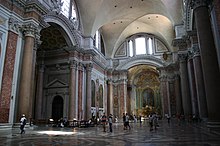
Frigidarium of Baths of Diocletian, at present Santa Maria degli Angeli
Marble isn’t discovered particularly near Rome, and was solely hardly ever used there earlier than Augustus, who famously boasted that he had discovered Rome made from brick and left it made from marble, although this was primarily as a dealing with for brick or concrete. The Temple of Hercules Victor of the late 2nd century BC is the earliest surviving exception in Rome. From Augustus’ reign the quarries at Carrara had been extensively developed for the capital, and different sources across the empire exploited,[12] particularly the distinguished Greek marbles like Parian. Travertine limestone was discovered a lot nearer, round Tivoli, and was used from the tip of the Republic; the Colosseum is principally constructed of this stone, which has good load-bearing capability, with a brick core.[13] Different kind of native stones had been used across the Empire.[14]
The Romans had been extraordinarily keen on luxurious imported colored marbles with fancy veining, and the interiors of an important buildings had been fairly often confronted with slabs of those, which have normally now been eliminated even the place the constructing survives. Imports from Greece for this objective started within the 2nd century BC.[15]
Roman brick

Shut-up view of the wall of the Roman shore fort at Burgh Citadel, Norfolk, displaying alternating programs of flint and brickwork.
The St. George Rotunda (4th century) and stays of Serdica, Sofia, Bulgaria
The Romans made fired clay bricks from in regards to the starting of the Empire, changing earlier sun-dried mudbrick. Roman brick was nearly invariably of a lesser peak than fashionable brick, however was made in a wide range of totally different sizes and shapes.[16] Shapes included sq., rectangular, triangular and spherical, and the most important bricks discovered have measured over three ft in size.[17] Historic Roman bricks had a basic dimension of 1½ Roman ft by 1 Roman foot, however widespread variations as much as 15 inches existed. Different brick sizes in historic Rome included 24″ x 12″ x 4″, and 15″ x 8″ x 10″. Historic Roman bricks present in France measured 8″ x 8″ x 3″. The Constantine Basilica in Trier is constructed from Roman bricks 15″ sq. by 1½” thick.[18] There’s usually little apparent distinction (notably when solely fragments survive) between Roman bricks used for partitions on the one hand, and tiles used for roofing or flooring on the opposite, so archaeologists typically want to make use of the generic time period ceramic constructing materials (or CBM).
The Romans perfected brick-making throughout the first century of their empire and used it ubiquitously, in private and non-private development alike. They took their brickmaking abilities in every single place they went, introducing the craft to the native populations.[18] The Roman legions, which operated their very own kilns, launched bricks to many components of the Empire; bricks are sometimes stamped with the mark of the legion that supervised their manufacturing. The usage of bricks in southern and western Germany, for instance, might be traced again to traditions already described by the Roman architect Vitruvius. Within the British Isles, the introduction of Roman brick by the traditional Romans was adopted by a 600–700 12 months hole in main brick manufacturing.
Roman concrete
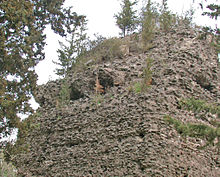
Instance of opus caementicium on a tomb on the traditional Appian Method in Rome. The unique protecting has been eliminated.
Concrete shortly supplanted brick as the first constructing materials,[citation needed] and extra daring buildings quickly adopted, with nice pillars supporting broad arches and domes slightly than dense strains of columns suspending flat architraves. The liberty of concrete additionally impressed the colonnade display screen, a row of purely ornamental columns in entrance of a load-bearing wall. In smaller-scale structure, concrete’s power freed the ground plan from rectangular cells to a extra free-flowing surroundings.[citation needed] Most of those developments are described by Vitruvius, writing within the first century BC in his work De architectura.
Though concrete had been used on a minor scale in Mesopotamia, Roman architects perfected Roman concrete and used it in buildings the place it might stand by itself and help quite a lot of weight. The primary use of concrete by the Romans was within the city of Cosa someday after 273 BC. Historic Roman concrete was a combination of lime mortar, mixture, pozzolana, water, and stones, and was stronger than previously-used concretes. The traditional builders positioned these elements in wood frames the place they hardened and bonded to a dealing with of stones or (extra regularly) bricks. The aggregates used had been usually a lot bigger than in fashionable concrete, amounting to rubble.
When the framework was eliminated, the brand new wall was very sturdy, with a tough floor of bricks or stones. This floor could possibly be smoothed and confronted with a sexy stucco or skinny panels of marble or different colored stones known as a “revetment”. Concrete development proved to be extra versatile and more cost effective than constructing stable stone buildings. The supplies had been available and never tough to move. The wood frames could possibly be used greater than as soon as, permitting builders to work shortly and effectively. Concrete is arguably the Roman contribution most related to fashionable structure.
Metropolis design

The Temple of Claudius to the south (left) of the Colosseum (mannequin of Imperial Rome on the Museo della civiltà romana in Rome)
The traditional Romans employed common orthogonal buildings on which they molded their colonies.[19][20][21] They in all probability had been impressed by Greek and Hellenic examples, in addition to by recurrently deliberate cities that had been constructed by the Etruscans in Italy.[22] (see Marzabotto)
The Romans used a consolidated scheme for metropolis planning, developed for navy protection and civil comfort. The fundamental plan consisted of a central discussion board with metropolis companies, surrounded by a compact, rectilinear grid of streets, and wrapped in a wall for protection. To scale back journey occasions, two diagonal streets crossed the sq. grid, passing via the central sq.. A river normally flowed via the town, offering water, transport, and sewage disposal.[23] Tons of of cities and cities had been constructed by the Romans all through their Empire.

Mannequin of the first century Philippopolis (Plovdiv, Bulgaria) within the Roman interval created by arch. Matey Mateev
Many European cities, resembling Turin, protect the stays of those schemes, which present the very logical approach the Romans designed their cities. They might lay out the streets at proper angles, within the type of a sq. grid. All roads had been equal in width and size, besides for 2, which had been barely wider than the others. Certainly one of these ran east–west, the opposite, north–south, they usually intersected within the center to kind the middle of the grid. All roads had been made from fastidiously fitted flagstones and crammed in with smaller, hard-packed rocks and pebbles. Bridges had been constructed the place wanted. Every sq. marked off by 4 roads was known as an insula, the Roman equal of a contemporary metropolis block.
Every insula was 80 yards (73 m) sq., with the land inside it divided. As the town developed, every insula would ultimately be crammed with buildings of assorted sizes and shapes and crisscrossed with again roads and alleys. Most insulae got to the primary settlers of a Roman metropolis, however every individual needed to pay to assemble his personal home.
Roman Izquierdo Bouldstridge Designs Elegant Vaulted Port Vell Oyster Bar
The town was surrounded by a wall to guard it from invaders and to mark the town limits. Areas exterior metropolis limits had been left open as farmland. On the finish of every important highway was a big gateway with watchtowers. A portcullis lined the opening when the town was beneath siege, and extra watchtowers had been constructed alongside the town partitions. An aqueduct was constructed exterior the town partitions.
The event of Greek and Roman urbanization is well-known, as there are comparatively many written sources, and there was a lot consideration to the topic, because the Romans and Greeks are usually thought to be the primary ancestors of recent Western tradition. It shouldn’t be forgotten, although, that the Etruscans had many appreciable cities and there have been additionally different cultures with kind of city settlements in Europe, primarily of Celtic origin.[24
Constructing sorts
Amphitheatre

The Amphitheatre of Pompeii, constructed round 70 BC and buried by the eruption of Mount Vesuvius 79 AD, as soon as hosted spectacles with gladiators
The amphitheatre was, with the triumphal arch and basilica, the one main new kind of constructing developed by the Romans.[25] A few of the most spectacular secular buildings are the amphitheatres, over 200 being identified and plenty of of that are nicely preserved, resembling that at Arles, in addition to its progenitor, the Colosseum in Rome. They had been used for gladiatorial contests, public shows, public conferences and bullfights, the custom of which nonetheless survives in Spain and Portugal. Their typical form, capabilities and title distinguish them from Roman theatres, that are kind of semicircular in form; from the circuses (akin to hippodromes) whose for much longer circuits had been designed primarily for horse or chariot racing occasions; and from the smaller stadia, which had been primarily designed for athletics and footraces.[26]
The earliest Roman amphitheatres date from the center of the primary century BC, however most had been constructed beneath Imperial rule, from the Augustan interval (27 BC–14 AD) onwards.[27] Imperial amphitheatres had been constructed all through the Roman Empire; the most important might accommodate 40,000–60,000 spectators, and essentially the most elaborate featured multi-storeyed, arcaded façades and had been elaborately adorned with marble, stucco and statuary.[28] After the tip of gladiatorial video games within the fifth century and of animal killings within the sixth, most amphitheatres fell into disrepair, and their supplies had been mined or recycled. Some had been razed, and others transformed into fortifications. A number of continued as handy open assembly locations; in a few of these, church buildings had been sited.[29]
Architecturally, they’re usually an instance of the Roman use of the classical orders to brighten massive concrete partitions pierced at intervals, the place the columns don’t have anything to help. Aesthetically, nonetheless, the method is profitable.

Northern aisle of the Basilica of Maxentius in Rome
The Aula Palatina of Trier, Germany (then a part of the Roman province of Gallia Belgica), constructed throughout the reign of Constantine I (r. 306–337 AD)
Basilica
The Roman basilica was a big public constructing the place enterprise or authorized issues could possibly be transacted. They had been usually the place the magistrates held court docket, and used for different official ceremonies, having most of the capabilities of the fashionable city corridor. The primary basilicas had no spiritual perform in any respect. As early because the time of Augustus, a public basilica for transacting enterprise had been a part of any settlement that thought-about itself a metropolis, utilized in the identical approach because the late medieval lined market homes of northern Europe, the place the assembly room, for lack of city house, was set above the arcades, nonetheless. Though their kind was variable, basilicas usually contained inside colonnades that divided the house, giving aisles or arcaded areas on one or either side, with an apse at one finish (or much less usually at every finish), the place the magistrates sat, usually on a barely raised dais. The central aisle tended to be huge and was greater than the flanking aisles, in order that gentle might penetrate via the clerestory home windows.
The oldest identified basilica, the Basilica Porcia, was inbuilt Rome in 184 BC by Cato the Elder throughout the time he was censor. Different early examples embrace the basilica at Pompeii (late 2nd century BC). After Christianity turned the official faith, the basilica form was discovered applicable for the primary massive public church buildings, with the attraction of avoiding reminiscences of the Greco-Roman temple kind.
Circus
The Roman circus was a big open-air venue used for public occasions within the historic Roman Empire. The circuses had been much like the traditional Greek hippodromes, though circuses served various functions and differed in design and development. Together with theatres and amphitheatres, circuses had been one of many important leisure websites of the time. Circuses had been venues for chariot racing, horse races, and performances that commemorated vital occasions of the Empire had been carried out there. For occasions that concerned re-enactments of naval battles, the circus was flooded with water.
The efficiency house of the Roman circus was usually, regardless of its title, an rectangular rectangle of two linear sections of race observe, separated by a median strip operating alongside the size of about two thirds the observe, joined at one finish with a semicircular part and on the different finish with an undivided part of observe closed (typically) by a particular beginning gate generally known as the carceres, thereby making a circuit for the races.
Discussion board
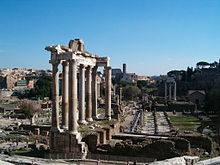
The Roman Discussion board
Through the years of the Republic, Augustus claimed he “discovered the town in brick and left it in marble”.[30] Whereas likelihood is excessive that this was an exaggeration, there’s something to be stated for the inflow of marble use in Roman Discussion board from 63 BC onwards. Throughout Augustus reign, the Discussion board was described to have been “a bigger, freer house than was the Discussion board of Imperial occasions.”[31] The Discussion board started to tackle much more adjustments upon the arrival of Julius Caesar, who drew out intensive plans for the market hub. Whereas Caesar’s loss of life got here prematurely, the concepts himself, in addition to Augustus had regarding the Discussion board proved to be essentially the most influential for years to come back. In line with Walter Dennison’s The Roman Discussion board As Cicero Noticed It, the writer writes that “the diverting of public enterprise to the bigger and splendid Imperial fora erected within the neighborhood resulted in leaving the final design of the Discussion board Romanum”.[31]
Each metropolis had at the very least one discussion board of various dimension. Along with its customary perform as a market, a discussion board was a gathering place of nice social significance, and infrequently the scene of various actions, together with political discussions and debates, rendezvous, conferences, and many others. A lot the very best identified instance is the Roman Discussion board, the earliest of a number of in Rome. In new Roman cities the discussion board was normally situated at, or simply off, the intersection of the primary north–south and east–west streets (the cardo and decumanus). All boards would have a Temple of Jupiter on the north finish, and would additionally include different temples, in addition to the basilica; a public weights and measures desk, so clients on the market might guarantee they weren’t being offered quick measures; and would usually have the baths close by.

A panoramic view of the Discussion board Trajanum, with the Trajan’s Column on the far left.
Horreum
The Horrea Epagathiana et Epaphroditiana, a horreum in Ostia (Rome), Italy, constructed c. 145–150 AD
A horreum was a kind of public warehouse used throughout the historic Roman interval. Though the Latin time period is usually used to consult with granaries, Roman horrea had been used to retailer many different forms of consumables; the large Horrea Galbae in Rome had been used not solely to retailer grain but in addition olive oil, wine, foodstuffs, clothes and even marble.[32] By the tip of the Imperial interval, the town of Rome had practically 300 horrea to provide its calls for.[33] The most important had been huge, even by fashionable requirements; the Horrea Galbae contained 140 rooms on the bottom flooring alone, protecting an space of some 225,000 sq. ft (21,000 m2).[34]
The primary horrea had been inbuilt Rome in direction of the tip of the 2nd century BC,[35] with the primary identified public horreum being constructed by the ill-fated tribune Gaius Gracchus in 123 BC.[36] The phrase got here to be utilized to anyplace designated for the preservation of products; thus, it was usually used consult with cellars (horrea subterranea), nevertheless it is also utilized to a spot the place artworks had been saved,[37] and even to a library.[38] Some public horrea functioned considerably like banks, the place valuables could possibly be saved, however an important class of horrea had been these the place foodstuffs resembling grain and olive oil had been saved and distributed by the state.[39]
The phrase itself is believed to have linguist roots tied to the phrase hordeum, which in Latin means barley.[40] Within the Johns Hopkins College Press, The Classical Weekly states that “Pliny the Elder does certainly make a distinction between the 2 phrases. He describes the horreum as a construction made from brick, the partitions of which weren’t lower than three ft thick; it had no home windows or openings for air flow”.[41] Moreover, the storehouses would additionally host oil and wine and in addition make the most of massive jars that might function cache’s for giant quantities of merchandise. These storehouses had been additionally used to deal with maintain massive sums of cash and had been used very similar to private storage models at present are. Romans had been “These horrea had been divided and subdivided, in order that one might rent solely a lot house as one needed, a complete room (cella), a closet (armarium), or solely a chest or sturdy field (arca, arcula, locus, loculus).”[41]
Insula
Insula in Ostia Antica
Multi-story condo blocks known as insulae catered to a spread of residential wants. The most cost effective rooms had been on the prime owing to the shortcoming to flee within the occasion of a fireplace and the dearth of piped water. Home windows had been principally small, dealing with the road, with iron safety bars. Insulae had been usually harmful, unhealthy, and liable to fires due to overcrowding and haphazard cooking preparations.[citation needed] There are examples within the Roman port city of Ostia, that date again to the reign of Trajan, however they appear to have been discovered solely in Rome and some different locations. Elsewhere writers report them as one thing outstanding, however Livy and Vitruvius consult with them in Rome.[42] Exterior partitions had been in opus reticulatum and interiors in opus incertum, which might then be plastered and typically painted.
To loosen up the small darkish rooms, tenants in a position to afford a level of painted vibrant murals on the partitions. Examples have been discovered of jungle scenes with wild animals and unique vegetation. Imitation home windows (trompe-l’œil) had been typically painted to make the rooms appear much less confined.
Historic Rome had elaborate and splendid homes owned by the elite. The common home, or in cities condo, of a commoner or plebeius didn’t include many luxuries. The domus, or single-family residence, was just for the well-off in Rome, with most having a format of the closed unit, consisting of 1 or two rooms. Between 312 and 315 AD Rome had 1781 domus and 44,850 of insulae.[43]
Insulae have been the topic of nice debate for historians of Roman tradition, defining the varied meanings of the phrase.[44] Insula was a phrase used to explain condo buildings, or the residences themselves,[45] that means condo, or inhabitable room, demonstrating simply how small residences for plebeians had been. City divisions had been initially road blocks, and later started to divide into smaller divisions, the phrase insula referring to each blocks and smaller divisions. The insula contained cenacula, tabernae, storage rooms beneath the steps, and decrease flooring outlets. One other kind of housing unit for plebs was a cenaculum, an condo, divided into three particular person rooms: cubiculum, exedra, and medianum. Frequent Roman residences had been primarily lots of smaller and bigger buildings, many with slim balconies that current mysteries as to their use, having no doorways to entry them, they usually lacked the extreme ornament and show of wealth that aristocrats’ homes contained. Luxurious in homes was not widespread, because the lifetime of the common individual didn’t include being of their homes, as they as a substitute would go to public baths, and have interaction in different communal actions.
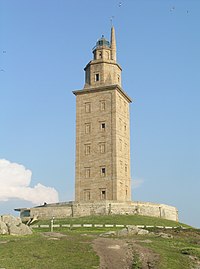
The Tower of Hercules, a Roman lighthouse in Spain
Lighthouses
Many lighthouses had been constructed across the Mediterranean and the coasts of the empire, together with the Tower of Hercules at A Coruña in northern Spain, a construction which survives to at the present time. A smaller lighthouse at Dover, England additionally exists as a spoil about half the peak of the unique. The sunshine would have been supplied by a fireplace on the prime of the construction.
Thermae
All Roman cities had at the very least one thermae, a preferred facility for public bathing, exercising and socializing. Train would possibly embrace wrestling and weight-lifting, in addition to swimming. Bathing was an vital a part of the Roman day, the place some hours is perhaps spent, at a really low value sponsored by the federal government. Wealthier Romans had been usually accompanied by a number of slaves, who carried out any required duties resembling fetching refreshment, guarding valuables, offering towels, and on the finish of the session, making use of olive oil to their masters’ our bodies, which was then scraped off with a strigil, a scraper made from wooden or bone.
Roman bath-houses had been additionally supplied for personal villas, city homes and forts. They had been usually equipped with water from an adjoining river or stream, or by aqueduct. The design of thermae is mentioned by Vitruvius in De architectura.
Temples

“Roman Baroque” Temple of Bacchus at Baalbek, Lebanon
Roman temples had been among the many most vital and richest buildings in Roman tradition, although only some survive in any kind of full state. Their development and upkeep was a serious a part of historic Roman faith, and all cities of any significance had at the very least one important temple, in addition to smaller shrines. The principle room (cella) housed the cult picture of the deity to whom the temple was devoted, and infrequently a small altar for incense or libations. Behind the cella was a room or rooms utilized by temple attendants for storage of kit and choices.
Some stays of many Roman temples survive, above all in Rome itself, however the comparatively few near-complete examples had been practically all transformed to Christian church buildings, normally a substantial time after the preliminary triumph of Christianity beneath Constantine. The decline of Roman faith was comparatively sluggish, and the temples themselves weren’t appropriated by the federal government till a decree of the Emperor Honorius in 415. A few of the oldest surviving temples embrace the Temple of Hercules Victor (mid 2nd century BC) and Temple of Portunus (120–80 BC), each standing throughout the Discussion board Boarium. Unique marble columns of the Temple of Janus in Rome’s Discussion board Holitorium, devoted by Gaius Duilius after his naval victory on the Battle of Mylae in 260 BC,[46] nonetheless stand as a element of the outside wall of the Renaissance period church of San Nicola in Carcere.
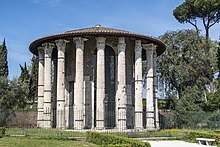
The Temple of Hercules Victor, Rome, constructed within the mid-2nd century BC, most probably by Lucius Mummius Achaicus, who received the Achaean Battle.
The type of the Roman temple was primarily derived from the Etruscan mannequin, however utilizing Greek types[citation needed]. Roman temples emphasised the entrance of the constructing, which adopted Greek temple fashions and usually consisted of huge steps resulting in a portico with columns, a pronaos, and normally a triangular pediment above, which was crammed with statuary in essentially the most grand examples; this was as usually in terracotta as stone, and no examples have survived besides as fragments. Nonetheless, in contrast to the Greek fashions, which usually gave equal therapy to all sides of the temple, which could possibly be considered and approached from all instructions, the perimeters and rear of Roman temples is perhaps largely undecorated (as within the Pantheon, Rome and Vic), inaccessible by steps (as within the Maison Carrée and Vic), and even again on to different buildings. As within the Maison Carrée, columns on the facet is perhaps engaged columns, rising from (“engaged with” in architectural terminology) the wall.[47] The platform on which the temple sat was usually raised greater in Roman examples than Greek, with up ten or twelve or extra steps slightly than the three typical in Greek temples; the Temple of Claudius was raised twenty steps. These steps had been usually solely on the entrance, and usually not the entire width of that.
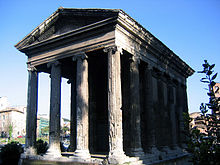
The Temple of Portunus, god of grain storage, keys, livestock and ports.[48] Rome, constructed between 120 and 80 BC
The Greek classical orders in all their particulars had been intently adopted within the façades of temples, as in different prestigious buildings. Nonetheless, the idealized proportions between the totally different parts set out by the one important Roman author on structure to outlive, Vitruvius, and subsequent Italian Renaissance writers, don’t mirror precise Roman observe, which could possibly be very variable, although all the time aiming at steadiness and concord. Following a Hellenistic pattern, the Corinthian order and its variant the Composite order had been commonest in surviving Roman temples, however for small temples like that at Alcántara, a easy Tuscan order could possibly be used.[49]
There was appreciable native variation in model, as Roman architects usually tried to include parts the inhabitants anticipated in its sacred structure. This was particularly the case in Egypt and the Close to East, the place totally different traditions of enormous stone temples had been already millennia previous. The Romano-Celtic temple was a easy model for small temples discovered within the Western Empire, and by far the commonest kind in Roman Britain. It usually lacked any of the distinctive classical options, and will have had appreciable continuity with pre-Roman temples of the Celtic faith.
Theatres
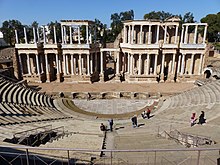
Roman Theatre (Mérida), Spain
Roman theatres had been inbuilt all areas of the Empire, from Spain to the Center East. Due to the Romans’ potential to affect native structure, we see quite a few theatres world wide with uniquely Roman attributes.[50]
These buildings had been semi-circular and possessed sure inherent architectural buildings, with minor variations relying on the area during which they had been constructed. The scaenae frons was a excessive again wall of the stage flooring, supported by columns. The proscaenium was a wall that supported the entrance fringe of the stage with ornately adorned niches off to the perimeters. The Hellenistic affect is seen via using the proscaenium. The Roman theatre additionally had a podium, which typically supported the columns of the scaenae frons. The scaenae was initially not a part of the constructing itself, constructed solely to offer adequate background for the actors. Finally, it turned part of the edifice itself, made out of concrete. The theatre itself was divided into the stage (orchestra) and the seating part (auditorium). Vomitoria or entrances and exits had been made out there to the viewers.[51]
Villa

Villa of the Mysteries simply exterior Pompeii, seen from above
A Roman villa was a rustic home constructed for the higher class, whereas a domus was a rich household’s home in a city. The Empire contained many sorts of villas, not all of them lavishly appointed with mosaic flooring and frescoes. Within the provinces, any nation home with some ornamental options within the Roman model could also be known as a “villa” by fashionable students.[52] Some, like Hadrian’s Villa at Tivoli, had been pleasure palaces resembling those who had been located within the cool hills inside simple attain of Rome or, just like the Villa of the Papyri at Herculaneum, on picturesque websites overlooking the Bay of Naples. Some villas had been extra just like the nation homes of England, the seen seat of energy of a neighborhood magnate, such because the well-known palace rediscovered at Fishbourne in Sussex.
Suburban villas on the sting of cities had been additionally identified, such because the Center and Late Republican villas that encroached on the Campus Martius, at the moment on the sting of Rome, and which might be additionally seen exterior the town partitions of Pompeii, together with the Villa of the Mysteries, well-known for its frescos. These early suburban villas, such because the one at Rome’s Auditorium web site[53] or at Grottarossa in Rome, exhibit the antiquity and heritage of the villa suburbana in Central Italy. It’s doable that these early, suburban villas had been additionally in actual fact the seats of energy (possibly even palaces) of regional strongmen or heads of vital households (gentes).
A 3rd kind of villa supplied the organizational heart of the big farming estates known as latifundia; such villas is perhaps missing in luxuries. By the 4th century, villa might merely imply an agricultural property or holding: Jerome translated the Gospel of Mark (xiv, 32) chorion, describing the olive grove of Gethsemane, with villa, with out an inference that there have been any dwellings there in any respect (Catholic Encyclopedia “Gethsemane”).
With the colossal Diocletian’s Palace, constructed within the countryside however later was a fortified metropolis, a type of residential fortress emerges, that anticipates the Center Ages.
Watermills
The preliminary invention of the watermill seems to have occurred within the Hellenized jap Mediterranean within the wake of the conquests of Alexander the Nice and the rise of Hellenistic science and know-how.[54][55][56] Within the subsequent Roman period, using water-power was diversified and various kinds of watermills had been launched. These embrace all three variants of the vertical water wheel in addition to the horizontal water wheel.[57][58] Other than its important use in grinding flour, water-power was additionally utilized to pounding grain,[59][60][61] crushing ore,[62] sawing stones[63] and probably fulling and bellows for iron furnaces.[64]
Ornamental buildings
Monoliths

The capital of Trajan’s Column, Rome
In structure, a monolith is a construction which has been excavated as a unit from a surrounding matrix or outcropping of rock.[65] Monoliths are present in all forms of Roman buildings. They had been both: quarried with out being moved; or quarried and moved; or quarried, moved and lifted clear off the bottom into their place (e.g., architraves); or quarried, moved and erected in an upright place (e.g., columns).
Transporting was completed by land or water (or a mixture of each), within the later case usually by special-built ships resembling obelisk carriers.[66] For lifting operations, historic cranes had been employed since c. 515 BC,[67] resembling within the development of Trajan’s Column.[68]
Obelisks
An obelisk is a tall, four-sided, slim tapering monument which ends in a pyramid-like form on the prime. These had been initially known as “tekhenu” by the builders, the traditional Egyptians. The Greeks who noticed them used the Greek ‘obeliskos’ to explain them, and this phrase handed into Latin after which English.[69] The Romans commissioned obelisks in an historic Egyptian model. Examples embrace:
- Arles, France – the Arles Obelisk, in Place de la République, a 4th-century obelisk of Roman origin
- Benevento, Italy – three Roman obelisks[70][71]
- Munich – obelisk of Titus Sextius Africanus, Staatliches Museum Ägyptischer Kunst, Kunstareal, 1st century AD, 5.80 m
- Rome – there are 5 historic Roman obelisks in Rome.
Roman gardens

Gardens in Conimbriga, Portugal
Roman gardens had been influenced by Egyptian, Persian, and Greek gardening strategies[citation needed]. In Historic Latium, a backyard was a part of each farm. In line with Cato the Elder, each backyard needs to be near the home and will have flower beds and decorative bushes.[72] Horace wrote that in his time flower gardens turned a nationwide indulgence.[73]
Gardens weren’t reserved for the extraordinarily rich. Excavations in Pompeii present that gardens attaching to residences had been scaled down to fulfill the house constraints of the house of the common Roman. Modified variations of Roman backyard designs had been adopted in Roman settlements in Africa, Gaul, and Britannia. As city homes had been changed by tall insulae (condo buildings), these city gardens had been changed by window packing containers or roof gardens.[citation needed]
Triumphal arches

The Arch of Titus in Rome, an early Roman imperial triumphal arch with a single archway
A triumphal arch is a monumental construction within the form of an archway with a number of arched passageways, usually designed to span a highway. The origins of the Roman triumphal arch are unclear. There have been precursors to the triumphal arch throughout the Roman world; in Italy, the Etruscans used elaborately adorned single bay arches as gates or portals to their cities. Surviving examples of Etruscan arches can nonetheless be seen at Perugia and Volterra.[74] The 2 key parts of the triumphal arch – a round-topped arch and a sq. entablature – had lengthy been in use as separate architectural parts in historic Greece.
The innovation of the Romans was to make use of these parts in a single free-standing construction. The columns turned purely ornamental parts on the outer face of arch, whereas the entablature, liberated from its function as a constructing help, turned the body for the civic and non secular messages that the arch builders wished to convey.[75] Little is understood about how the Romans considered triumphal arches. Pliny the Elder, writing within the first century AD, was the one historic writer to debate them.[76] He wrote that they had been supposed to “elevate above the peculiar world” a picture of an honoured individual normally depicted within the type of a statue with a quadriga.[76]

The Arch of Augustus in Rimini (Ariminum), devoted to Augustus by the Roman Senate in 27 BC, the oldest surviving Roman triumphal arch
The primary recorded Roman triumphal arches had been arrange within the time of the Roman Republic.[77] Generals who had been granted a triumph had been termed triumphators and would erect fornices or honorific arches bearing statues to commemorate their victories.[78]
Roman triumphal practices modified considerably at first of the Imperial interval, when the primary Roman Emperor Augustus decreed that solely emperors can be granted triumphs. The triumphal arch modified from being a private monument to being an primarily propagandistic one, serving to announce and promote the presence of the ruler and the legal guidelines of the state.[74] Arches weren’t essentially constructed as entrances, however – in contrast to many fashionable triumphal arches – they had been usually erected throughout roads and had been supposed to be handed via, not spherical.[79]
Most Roman triumphal arches had been constructed throughout the Imperial interval. By the fourth century AD there have been 36 such arches in Rome, of which three have survived – the Arch of Titus (AD 81), the Arch of Septimius Severus (203–205) and the Arch of Constantine (312). Quite a few arches had been constructed elsewhere within the Roman Empire.[77] The one arch was the commonest, however many triple arches had been additionally constructed, of which the Triumphal Arch of Orange (c. AD 21) is the earliest surviving instance. From the 2nd century AD, many examples of the arcus quadrifrons – a sq. triumphal arch erected over a crossroads, with arched openings on all 4 sides – had been constructed, particularly in North Africa. Arch-building in Rome and Italy diminished after the time of Trajan (AD 98–117) however remained widespread within the provinces throughout the 2nd and third centuries AD; they had been usually erected to commemorate imperial visits.[78]
The ornamentation of an arch was supposed to function a continuing visible reminder of the triumph and triumphator. The façade was ornamented with marble columns, and the piers and attics with ornamental cornices. Sculpted panels depicted victories and achievements, the deeds of the triumphator, the captured weapons of the enemy or the triumphal procession itself. The spandrels normally depicted flying Victories, whereas the attic was usually inscribed with a dedicatory inscription naming and praising the triumphator. The piers and inside passageways had been additionally adorned with reliefs and free-standing sculptures. The vault was ornamented with coffers. Some triumphal arches had been surmounted by a statue or a currus triumphalis, a bunch of statues depicting the emperor or basic in a quadriga.[74][78]
Inscriptions on Roman triumphal arches had been artworks in themselves, with very finely reduce, typically gilded letters. The type of every letter and the spacing between them was fastidiously designed for max readability and ease, with none ornamental thrives, emphasizing the Roman style for restraint and order. This conception of what later turned the artwork of typography stays of elementary significance down to the current day.[79]
Victory columns
Infrastructure
Roads
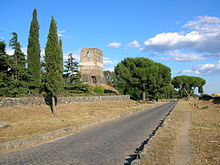
The Appian approach
Roman roads had been important to the upkeep and growth of the Roman state, and had been constructed from about 500 BC via the growth and consolidation of the Roman Republic and the Roman Empire.[80] They supplied environment friendly means for the overland motion of armies, officers and civilians, and the inland carriage of official communications and commerce items.[81] On the peak of Rome’s growth, no fewer than 29 nice navy highways radiated from the capital, and the Late Empire’s 113 provinces had been interconnected by 372 nice highway hyperlinks.[82][83]
Roman highway builders aimed toward a regulation width (see Legal guidelines and requirements above), however precise widths have been measured at between 3.6 ft (1.1 m) and greater than 23 ft (7.0 m). Immediately, the concrete has worn from the areas across the stones, giving the impression of a really bumpy highway, however the authentic observe was to supply a floor that was little doubt a lot nearer to being flat.
Aqueduct

The Pont du Gard, close to Vers-Pont-du-Gard, France
The Romans constructed quite a few aqueducts as a way to carry water from distant sources into their cities and cities, supplying public baths, latrines, fountains and personal households. Waste water was eliminated by complicated sewage programs and launched into close by our bodies of water, maintaining the cities clear and free from effluent. Aqueducts additionally supplied water for mining operations, milling, farms and gardens.
Aqueducts moved water via gravity alone, being constructed alongside a slight downward gradient inside conduits of stone, brick or concrete. Most had been buried beneath the bottom, and adopted its contours; obstructing peaks had been circumvented or, much less usually, tunnelled via. The place valleys or lowlands intervened, the conduit was carried on bridgework, or its contents fed into high-pressure lead, ceramic or stone pipes and siphoned throughout. Most aqueduct programs included sedimentation tanks, sluices and distribution tanks to control the provision at want.
Historic Rome’s first aqueduct – the Aqua Appia – equipped a water-fountain sited on the metropolis’s cattle market within the fourth century BC. By the third century AD, the town had eleven aqueducts, sustaining a inhabitants of over one million in a water-extravagant financial system; a lot of the water equipped the town’s many public baths. Cities and municipalities all through the Roman Empire emulated this mannequin and funded aqueducts as objects of public curiosity and civic satisfaction, “an costly but essential luxurious to which all might, and did, aspire.”[84]
Most Roman aqueducts proved dependable, and sturdy; some had been maintained into the early fashionable period, and some are nonetheless partly in use. Strategies of aqueduct surveying and development are famous by Vitruvius in his work De architectura (1st century BC). The overall Frontinus offers extra element in his official report on the issues, makes use of and abuses of Imperial Rome’s public water provide. Notable examples of aqueduct structure embrace the supporting piers of the Aqueduct of Segovia, and the aqueduct-fed cisterns of Constantinople.
Bridges
Roman bridges, constructed by historic Romans, had been the primary massive and lasting bridges constructed.[85] Roman bridges had been constructed with stone and had the arch as the essential construction. Most utilized concrete as nicely, which the Romans had been the primary to make use of for bridges.

Puente Romano over the Guadiana River at Mérida, Spain
Roman arch bridges had been normally semicircular, though a couple of had been segmental (resembling Alconétar Bridge). A segmental arch is an arch that’s lower than a semicircle.[86] Some great benefits of the segmental arch bridge had been that it allowed nice quantities of flood water to cross beneath it, which might stop the bridge from being swept away throughout floods and the bridge itself could possibly be extra light-weight. Usually, Roman bridges featured wedge-shaped main arch stones (voussoirs) of the identical in dimension and form. The Romans constructed each single spans and prolonged a number of arch aqueducts, such because the Pont du Gard and Segovia Aqueduct. Their bridges featured from an early time onwards flood openings within the piers, e.g. within the Pons Fabricius in Rome (62 BC), one of many world’s oldest main bridges nonetheless standing. Roman engineers had been the primary and till the Industrial Revolution the one ones to assemble bridges with concrete, which they known as opus caementicium. The skin was normally lined with brick or ashlar, as within the Alcántara bridge.
The Romans additionally launched segmental arch bridges into bridge development. The 330 m lengthy Limyra Bridge in southwestern Turkey options 26 segmental arches with a median span-to-rise ratio of 5.3:1,[87] giving the bridge an unusually flat profile unsurpassed for greater than a millennium. Trajan’s bridge over the Danube featured open-spandrel segmental arches made from wooden (standing on 40 m excessive concrete piers). This was to be the longest arch bridge for a thousand years each when it comes to total and particular person span size, whereas the longest extant Roman bridge is the 790 m lengthy Puente Romano at Mérida.
Canals
Roman canals had been usually multi-purpose buildings, supposed for irrigation, drainage, land reclamation, flood management and navigation the place possible. Some navigational canals had been recorded by historic geographers and are nonetheless traceable by fashionable archaeology. Channels which served the wants of city water provide are lined on the Listing of aqueducts within the Roman Empire.
Cisterns
The Basilica Cistern in Constantinople supplied water for the Imperial Palace.
Freshwater reservoirs had been generally arrange on the termini of aqueducts and their department strains, supplying city households, agricultural estates, imperial palaces, thermae or naval bases of the Roman navy.[88]
Dams
Roman dam development started in earnest within the early imperial interval.[89] For essentially the most half, it targeting the semi-arid fringe of the empire, specifically the provinces of North Africa, the Close to East, and Hispania.[90][91][92] The relative abundance of Spanish dams beneath is due partly to extra intensive subject work there; for Italy solely the Subiaco Dams, created by emperor Nero (54–68 AD) for leisure functions, are attested.[93][89] These dams are noteworthy, although, for his or her extraordinary peak, which remained unsurpassed anyplace on this planet till the Late Center Ages.[89]
Essentially the most frequent dam sorts had been earth- or rock-filled embankment dams and masonry gravity dams.[94] These served a big selection of functions, resembling irrigation, flood management, river diversion, soil-retention, or a mixture of those capabilities.[95] The impermeability of Roman dams was elevated by the introduction of waterproof hydraulic mortar and particularly opus caementicium within the Concrete Revolution. These supplies additionally allowed for larger buildings to be constructed,[96] just like the Lake Homs Dam, probably the most important water barrier at present,[97] and the sturdy Harbaqa Dam, each of which include a concrete core.
Roman builders had been the primary to comprehend the stabilizing impact of arches and buttresses, which they built-in into their dam designs. Beforehand unknown dam sorts launched by the Romans embrace arch-gravity dams,[92][98] arch dams,;[99][100][101][102][103] buttress dams,[104] and multiple-arch buttress dams.[105][106][98][107]
Defensive partitions

Roman partitions of Lugo, Spain
The Romans usually fortified cities slightly than fortresses, however there are some fortified camps such because the Saxon Shore forts like Porchester Citadel in England. Metropolis partitions had been already important in Etruscan structure, and within the wrestle for management of Italy beneath the early Republic many extra had been constructed, utilizing totally different strategies. These included tightly becoming large irregular polygonal blocks, formed to suit precisely in a approach harking back to later Inca work. The Romans known as a easy rampart wall an agger; at this date nice peak was not essential. The Servian Wall round Rome was an bold undertaking of the early 4th century BC. The wall was as much as 10 metres (32.8 ft) in peak in locations, 3.6 metres (12 ft) huge at its base, 11 km (7 mi) lengthy,[108] and is believed to have had 16 important gates, although many of those are talked about solely from writings, with no different identified stays. A few of it had a fossa or ditch in entrance, and an agger behind, and it was sufficient to discourage Hannibal. Later the Aurelian Wall changed it, enclosing an expanded metropolis, and utilizing extra refined designs, with small forts at intervals.
The Romans walled main cities and cities in areas they noticed as susceptible, and components of many partitions stay included in later defensive fortifications, as at Córdoba (2nd century BC), Chester (earth and wooden within the 70s AD, stone from c. 100), and York (from 70s AD). Strategic partitions throughout open nation had been far rarer, and Hadrian’s Wall (from 122) and the Antonine Wall (from 142, deserted solely 8 years after completion) are essentially the most important examples, each on the Pictish frontier of Roman Britain.
Architectural options
Mosaics

The Centaur mosaic (2nd-century), discovered at Hadrian’s Villa in Tivoli, Italy. Altes Museum, Berlin
On his return from campaigns in Greece, the final Sulla introduced again what might be the best-known aspect of the early imperial interval: the mosaic, a ornament made from vibrant chips of stone inserted into cement. This tiling technique took the empire by storm within the late first century and the second century and within the Roman residence joined the well-known mural in adorning flooring, partitions, and grottoes with geometric and pictorial designs.
There have been two important strategies in Greco-Roman mosaic. Opus vermiculatum used tiny tesserae, usually cubes of 4 millimeters or much less, and was produced in workshops in comparatively small panels, which had been transported to the positioning glued to some momentary help. The tiny tesserae allowed very advantageous element and an method to the illusionism of portray. Usually small panels known as emblemata had been inserted into partitions or because the highlights of bigger floor-mosaics in coarser work. The traditional approach, nonetheless, was opus tessellatum, utilizing bigger tesserae, which had been laid on web site.[109] There was a definite native Italian model utilizing black on a white background, which was little doubt cheaper than absolutely colored work.[110]
A particular style of Roman mosaic obtained the title asaroton (Greek “unswept flooring”). It represented an optical phantasm of the leftovers from a feast on the ground of wealthy homes.[111]
Hypocaust

Hypocaust in Saint-Rémy-de-Provence, France
A hypocaust was an historic Roman system of underfloor heating, used to warmth homes with sizzling air. The Roman architect Vitruvius, writing in regards to the finish of the first century BC, attributes their invention to Sergius Orata. Many stays of Roman hypocausts have survived all through Europe, western Asia, and northern Africa. The hypocaust was an invention which improved the hygiene and residing situations of residents, and was a forerunner of recent central heating.
Hypocausts had been used for heating sizzling baths (thermae), homes and different buildings, whether or not public or non-public. The ground was raised above the bottom by pillars, known as pilae stacks, with a layer of tiles, then a layer of concrete, then one other of tiles on prime; and areas had been left contained in the partitions in order that sizzling air and smoke from the furnace would cross via these enclosed areas and out of flues within the roof, thereby heating however not polluting the inside of the room.
Roman roofs
Contained in the “Temple of Mercury” at Baiae, a swimming pool for a Roman tub, relationship to the late Roman Republic,[112] and containing one of many largest domes on this planet earlier than the constructing of the Pantheon
In Magna Graecia truss roofs presumably appeared as early as 550 BC.[113] Their potential was absolutely realized within the Roman interval, which noticed trussed roofs over 30 huge spanning the oblong areas of monumental public buildings resembling temples, basilicas, and later church buildings. Such spans had been 3 times as huge because the widest prop-and-lintel roofs and solely surpassed by the most important Roman domes.[114]
The most important truss roof by span of historic Rome lined the Aula Regia (throne room) constructed for emperor Domitian (81–96 AD) on the Palatine Hill, Rome. The timber truss roof had a width of 31.67 m, barely surpassing the postulated restrict of 30 m for Roman roof constructions. Tie-beam trusses allowed for a lot bigger spans than the older prop-and-lintel system and even concrete vaulting. 9 out of the ten largest rectangular areas in Roman structure had been bridged this fashion, the one exception being the groin vaulted Basilica of Maxentius.[114]
Spiral stairs
The spiral stair is a kind of stairway which, resulting from its complicated helical construction, was launched comparatively late into structure. Though the oldest instance dates again to the fifth century BC,[115] it was solely within the wake of the influential design of Trajan’s Column that this space-saving new kind completely caught maintain in Roman structure.[116]
Other than the triumphal columns within the imperial cities of Rome and Constantinople, different forms of buildings resembling temples, thermae, basilicas and tombs had been additionally fitted with spiral stairways.[116] Their notable absence within the towers of the Aurelian Wall signifies that though utilized in medieval castles, they didn’t but determine prominently in Roman navy engineering.[116] By late antiquity, separate stair towers had been constructed adjoining to the primary buildings, as within the Basilica of San Vitale.
The development of spiral stairs handed on each to Christian and Islamic structure.
Vital buildings and areas
The Baths of Caracalla

Canopo at Hadrian’s Villa, Tivoli, Italy

Verona Area at daybreak
Public buildings
- Baths of Trajan – these had been a large thermae, a washing and leisure complicated, inbuilt historic Rome ranging from 104 AD and devoted throughout the Kalends of July in 109.
- Baths of Diocletian – in historic Rome, these had been the grandest of the general public baths (thermae), constructed by successive emperors
- Baths of Caracalla
- Colosseum
- Trajan’s Column, in Rome
- Circus Maximus, in Rome
- Curia Hostilia (Senate Home), in Rome
- Domus Aurea (former constructing)
- Discussion board of Augustus
- Hadrian’s Villa
- Pantheon
- Tower of Hercules
- Tropaeum Traiani
- Verona Area, in Verona
- Rotunda Church of St. George, Serdika, Sofia, Bulgaria
- Roman theatre of Philippopolis, Plovdiv, Bulgaria
- Roman Stadium, Philippopolis, Plovdiv, Bulgaria
- Roman baths, Odessos, Varna, Bulgaria
- Roman metropolis partitions of Diocletianopolis (Thrace), Hisarya, Bulgaria
- Roman tomb, Primorsko, Bulgaria[117]
- Tholos
Personal structure
- Alyscamps – a necropolis in Arles, France, one of the crucial well-known necropolises of the traditional world
- Domus
- Catacombs of Rome
- Roman villa
- Pompeii
- Herculaneum
- Stabiae

Hadrian’s Wall, inbuilt 122 AD in Roman Britain, in what’s now Northern England
Civil engineering
- Roman engineering – Romans are well-known for his or her superior engineering accomplishments, though a few of their very own innovations had been enhancements on older concepts, ideas and innovations.
- Roman watermill
Navy engineering
- Castrum
- Antonine Wall
- Hadrian’s Wall
- Limes Germanicus
See additionally
 Historic Rome portal
Historic Rome portal Italy portal
Italy portal Historical past portal
Historical past portal Structure portal
Structure portal
- Define of historic Rome
- Define of structure
- Historic Greek structure
- Structure of Mesopotamia
- Achaemenid structure
- Roman know-how
Footnotes
Works cited
- Abbott, Frank Frost; Johnson, Allan Chester (1926). Municipal Administration within the Roman Empire. Princeton: Princeton College Press.
- Arenillas, Miguel; Castillo, Juan C. (2003), “Dams from the Roman Period in Spain. Evaluation of Design Types (with Appendix)”, 1st Worldwide Congress on Building Historical past [20th–24th January], Madrid
- Baker, Rosalie F.; Baker, Charles F. (2001). Historic Egyptians: Individuals of the Pyramids. Oxford College Press. ISBN 978-0-19-512221-3.
- Beckmann, Martin (2002), “The ‘Columnae Coc(h)lides’ of Trajan and Marcus Aurelius”, Phoenix, 56 (3/4): 348–357, doi:10.2307/1192605, JSTOR 1192605
- Benevolo, Leonardo (1993). Die Geschichte der Stadt. Frankfurt/Major New York: Campus-Verl. ISBN 978-3-593-34906-0.
- Bunson, Matthew (2009). “Engineering”. Encyclopedia of the Roman Empire. Infobase Publishing. ISBN 978-1-4381-1027-1.
- Bomgardner, David Lee (October 2000). The Story of the Roman Amphitheatre. Routledge. ISBN 978-0-415-16593-8.
- Coulton, J. J. (1974), “Lifting in Early Greek Structure”, The Journal of Hellenic Research, 94: 1–19, doi:10.2307/630416, JSTOR 630416, S2CID 162973494
- DeLaine, Janet (1990), “Structural Experimentation: The Lintel Arch, Corbel and Tie in Western Roman Structure”, World Archaeology, 21 (3): 407–424 (407), doi:10.1080/00438243.1990.9980116
- Donners, Ok.; Waelkens, M.; Deckers, J. (2002), “Water Mills within the Space of Sagalassos: A Disappearing Historic Expertise”, Anatolian Research, British Institute at Ankara, vol. 52, pp. 1–17, doi:10.2307/3643076, JSTOR 3643076, S2CID 163811541
- Demandt, Alexander (1998). Die Kelten (in German). München: Beck. ISBN 978-3-406-43301-6.
- Favro, Diane, et al. “Rome, historic, Structure.” Grove Artwork On-line. Oxford Artwork On-line. Oxford College Press, accessed 26 March 2016, subscription required
- Döring, Mathias (2002), “Wasser für den ‘Sinus Baianus’: Römische Ingenieur- und Wasserbauten der Phlegraeischen Felder”, Antike Welt, vol. 33, no. 3, pp. 305–319
- Forbes, Robert James (1993). Research in historic know-how. Vol. 2. Brill. ISBN 978-90-04-00622-5.
- Fürst, Ulrich; Grundmann, Stefan (1998). The structure of Rome: an architectural historical past in 400 shows. Version Axel Menges. ISBN 978-3-930698-60-8.
- Gagarin, Michael; Fantham, Elaine, eds. (2010). “Aqueducts”. The Oxford encyclopedia of historic Greece and Rome. Vol. 1. New York: Oxford College Press. ISBN 978-0-19-517072-6.
- Gardner, Helen (2005), Gardner’s Artwork By means of The Ages: The Western Perspective, Wadsworth Publishing, p. 170, ISBN 978-0-495-00479-0
- Harris, W. (1989). “Invisible Cities: the Starting of Etruscan Urbanization”. Atti del Secondo Congresso Internazionale Etrusco. Roma, 1989. pp. 375–392.
- Heinle, Erwin; Schlaich, Jörg (1996), Kuppeln aller Zeiten, aller Kulturen, Stuttgart, ISBN 978-3-421-03062-7
- Henig, Martin (ed), A Handbook of Roman Artwork, Chapter 2 “Structure” by Thomas Blagg, Phaidon, 1983, ISBN 0714822140
- Hermansen, G. (1970). “The Medianum and the Roman Residence”. Phoenix. 24 (4): 342–347. doi:10.2307/1087740. ISSN 0031-8299. JSTOR 1087740.
- Hodge, A. Trevor (1992), Roman Aqueducts & Water Provide, London: Duckworth, ISBN 978-0-7156-2194-3
- Hodge, A. Trevor (2000), “Reservoirs and Dams”, in Wikander, Örjan (ed.), Handbook of Historic Water Expertise, Expertise and Change in Historical past, vol. 2, Leiden: Brill, pp. 331–339, ISBN 978-90-04-11123-3
- Honour, Hugh; Fleming, John (2005). A world historical past of artwork. Laurence King Publishing. ISBN 978-1-85669-451-3.
- James, Patrick; Chanson, Hubert (2002), “Historic Growth of Arch Dams. From Roman Arch Dams to Trendy Concrete Designs”, Australian Civil Engineering Transactions, CE43: 39–56
- Juracek, Judy A. (1996). Surfaces: Visible Analysis for Artists, Architects, and Designers. W.W. Norton. ISBN 978-0-393-73007-4.
- Kaszynski, William (2000). The American Freeway: The Historical past and Tradition of Roads in america. Jefferson, N.C.: McFarland. ISBN 978-0-7864-0822-1.
- Kolb, Frank (1984). Die Stadt im Altertum. München: C.H. Beck. ISBN 978-3-406-03172-4.
- Lampe, Peter (2006). Christians at Rome within the first two centuries : from Paul to Valentinus. London: Continuum Worldwide Publishing Group. ISBN 978-0-8264-8102-3.
- Lancaster, Lynne (1999), “Constructing Trajan’s Column”, American Journal of Archaeology, 103 (3): 419–439, doi:10.2307/506969, JSTOR 506969, S2CID 192986322
- Lechtman, Heather; Hobbs, Linn (1986), “Roman Concrete and the Roman Architectural Revolution. Ceramics and Civilization”, in Kingery, W. D. (ed.), Excessive Expertise Ceramics: Previous, Current, Future, vol. 3, American Ceramics Society
- Hodge, A. Trevor (1960), The Woodwork of Greek Roofs, Cambridge College Press, pp. 38–44
- Mark, Robert; Hutchinson, Paul (1986), “On the Construction of the Roman Pantheon”, Artwork Bulletin, vol. 68, no. 1, pp. 24–34, doi:10.2307/3050861, JSTOR 3050861
- Métreaux, Man P.R. (1998). “Villa rustica alimentaria et annonaria”. In Frazer, Alfred (ed.). The Roman villa : villa urbana. Philadelphia: College Museum, College of Pennsylvania. ISBN 978-0-924171-59-8.
- Miller, Stella Grobel (1972). “A Mosaic Flooring from a Roman Villa at Anaploga” (PDF). Hesperia. 41 (3): 332–354. doi:10.2307/147437. ISSN 0018-098X. JSTOR 147437.
- Morris, Anthony E. (1972). Historical past of City Kind: Prehistory to the Renaissance. London: George Godwin Restricted. ISBN 978-0711438019.
- O’Connor, Colin (1993), Roman Bridges, Cambridge College Press, ISBN 978-0-521-39326-3
- O’Flaherty, C.A. (2002). “Introduction: A historic overview of the event of the highway” (PDF). Highways. pp. 1–5. doi:10.1016/B978-075065090-8/50002-8. ISBN 978-0-7506-5090-8.
- Patrich, Joseph (1996). “Warehouses and Granaries in Caesarea Maritima”. In Raban, Avner (ed.). Caesarea Maritima : a retrospective after two millennia. Leiden New York: E.J. Brill. ISBN 978-90-04-10378-8.
- Peet, Stephen Denison (1911). The American Antiquarian and Oriental Journal. Jameson & Morse.
- Potter, D. S.; Mattingly, D. J. (1999). Life, loss of life, and leisure within the Roman Empire. Ann Arbor: College of Michigan Press. ISBN 978-0-472-08568-2.
- Rasch, Jürgen (1985), “Die Kuppel in der römischen Architektur. Entwicklung, Formgebung, Konstruktion”, Architectura, vol. 15, pp. 117–139
- Richardson, Lawrence (1992). A brand new topographical dictionary of historic Rome. Baltimore: Johns Hopkins College Press. ISBN 978-0-8018-4300-6.
- Ritti, Tullia; Grewe, Klaus; Kessener, Paul (2007), “A Reduction of a Water-powered Stone Noticed Mill on a Sarcophagus at Hierapolis and its Implications”, Journal of Roman Archaeology, vol. 20, pp. 138–163
- Rook, Tony (1992), Roman Baths in Britain, Osprey Publishing, pp. 18–19, ISBN 978-0-7478-0157-3
- Ros, Karen E. (1996). “The Roman Theater at Carthage (the theater’s substructures, plan and the identification of architectural parts)”. American Journal of Archaeology. 100 (3): 449–489. doi:10.2307/507025. ISSN 0002-9114. JSTOR 507025. S2CID 191374710.
- Schmitz, Leonhard (1875). “Horreum”. In Smith, William (ed.). A Dictionary of Greek and Roman Antiquities. London: John Murray.
- Schnitter, Niklaus (1978), “Römische Talsperren”, Antike Welt, 8 (2): 25–32
- Schnitter, Niklaus (1987a), “Verzeichnis geschichtlicher Talsperren bis Ende des 17. Jahrhunderts”, in Garbrecht, Günther (ed.), Historische Talsperren, vol. 1, Stuttgart: Verlag Konrad Wittwer, pp. 9–20, ISBN 978-3-87919-145-1
- Schnitter, Niklaus (1987b), “Die Entwicklungsgeschichte der Pfeilerstaumauer”, in Garbrecht, Günther (ed.), Historische Talsperren, vol. 1, Stuttgart: Verlag Konrad Wittwer, pp. 57–74, ISBN 978-3-87919-145-1
- Schnitter, Niklaus (1987c), “Die Entwicklungsgeschichte der Bogenstaumauer”, in Garbrecht, Günther (ed.), Historische Talsperren, vol. 1, Stuttgart: Verlag Konrad Wittwer, pp. 75–96, ISBN 978-3-87919-145-1
- Semple, Ellen Churchill (July 1929). “Historic Mediterranean Pleasure Gardens”. Geographical Assessment. 19 (3): 420–443. doi:10.2307/209149. JSTOR 209149.
- Smith, D. J. (1983). “Mosaics”. In Martin Henig (ed.). A Handbook of Roman Artwork. Phaidon. ISBN 978-0-7148-2214-3.
- Smith, Norman (1970), “The Roman Dams of Subiaco”, Expertise and Tradition, 11 (1): 58–68, doi:10.2307/3102810, JSTOR 3102810
- Smith, Norman (1971), A Historical past of Dams, London: Peter Davies, pp. 25–49, ISBN 978-0-432-15090-0
- Storey, Glenn R. (2002). “Regionaries-Sort Insulae 2: Architectural/Residential Models at Rome”. American Journal of Archaeology. 106 (3): 411–434. doi:10.2307/4126281. ISSN 0002-9114. JSTOR 4126281. S2CID 163283487.
- Storey, Glenn R. (2004). “The Which means of “Insula” in Roman Residential Terminology”. Memoirs of the American Academy in Rome. 49: 47–84. doi:10.2307/4238817. ISSN 0065-6801. JSTOR 4238817.
- Sullivan, George H. (2006). Not inbuilt a day: exploring the structure of Rome. Da Capo Press. ISBN 978-0-7867-1749-1.
- Ulrich, Roger B. (2007). Roman Woodworking. Yale College Press. ISBN 978-0-300-10341-0.
- Vitrivius (1914). The Ten Books on Structure, Bk I. Morris H. Morgan (translator). Harvard College Press.
- Walters, Henry Beauchamp; Birch, Samuel (1905). Historical past of Historic Pottery: Greek, Etruscan, and Roman. John Murray.
- Ward-Perkins, Bryan (2000). “Chapter 12. Land, labour, and settlement” (PDF). In Cameron, Averil; Ward-Perkins, Bryan; Whitby, Michael (eds.). Late Antiquity: Empire and Successors A.D. 425–600. The Cambridge Historic Historical past. Vol. XIV. Cambridge College Press. Half III: East and West: Economic system and Society. doi:10.1017/CHOL9780521325912. hdl:2027/mdp.39015030095528. ISBN 978-0-521-32591-2.
- Ward-Perkins, J. B. (1956). “Nero’s Golden Home”. Antiquity. 30: 217–19.
- Wikander, Örjan (1985), “Archaeological Proof for Early Water-Mills. An Interim Report”, Historical past of Expertise, vol. 10, pp. 151–179
- Wikander, Örjan (2000a), “The Water-Mill”, in Wikander, Örjan (ed.), Handbook of Historic Water Expertise, Expertise and Change in Historical past, vol. 2, Leiden: Brill, pp. 371–400, ISBN 978-90-04-11123-3
- Wikander, Örjan (2000b), “Industrial Purposes of Water-Energy”, in Wikander, Örjan (ed.), Handbook of Historic Water Expertise, Expertise and Change in Historical past, vol. 2, Leiden: Brill, pp. 401–410, ISBN 978-90-04-11123-3
- Wilson, Andrew (2002), “Machines, Energy and the Historic Economic system”, The Journal of Roman Research, Society for the Promotion of Roman Research, Cambridge College Press, vol. 92, pp. 1–32, doi:10.2307/3184857, JSTOR 3184857, S2CID 154629776
- Wilson Jones, Mark (2000). Ideas of Roman structure. New Haven, Conn: Yale College Press. ISBN 978-0-300-08138-1.
- Wirsching, Armin (2000), “How the Obelisks Reached Rome: Proof of Roman Double-Ships”, The Worldwide Journal of Nautical Archaeology, 29 (2): 273–283, doi:10.1111/j.1095-9270.2000.tb01456.x, S2CID 162710923
- Zaho, Margaret Ann (2004). Imago triumphalis: the perform and significance of triumphal imagery for Italian Renaissance rulers. Peter Lang. ISBN 978-0-8204-6235-6.
Additional studying
- Adam, Jean Pierre. Roman Constructing: Supplies and Strategies. Bloomington: Indiana College Press, 1994.
- Anderson, James C. Roman Structure and Society. Baltimore: Johns Hopkins College Press, 1997.
- Boëthius, Axel. Etruscan and Early Roman Structure. New Haven: Yale College Press, 1994.
- Fant, J. Clayton. “Quarrying and Stoneworking.” In The Oxford Handbook of Engineering and Expertise within the Classical World, edited by John P. Oleson, 121–135. Oxford: Oxford College Press, 2008.
- Hopkins, John North. The Genesis of Roman Structure. New Haven: Yale College Press, 2016.
- Lancaster, Lynne C. Concrete Vaulted Building In Imperial Rome: Improvements In Context. Cambridge: Cambridge College Press, 2005.
- –. “Roman Engineering and Building.” In The Oxford Handbook of Engineering and Expertise within the Classical World, edited by John P. Oleson, 256–284. Oxford: Oxford College Press. 2008.
- MacDonald, William Lloyd. The Structure of the Roman Empire. Rev. ed. New Haven: Yale College Press, 1982.
- Macready, Sarah, and F. H. Thompson. Roman structure within the Greek world. London: Society of Antiquaries, 1987.
- Sear, Frank. Roman Structure. Ithaca: Cornell College Press, 1983.
- Thomas, Edmund V. Monumentality and the Roman Empire: Structure within the Antonine age. Oxford: Oxford College Press, 2007.
- Ulrich, Roger B. Roman Woodworking. New Haven: Yale College Press, 2007.
- Ulrich, Roger B., and Caroline Ok Quenemoen. A Companion to Roman Structure. Somerset: Wiley, 2013.
| Library assets about Historic Roman structure |
|
- Traianus – Technical investigation of Roman public works
- Housing and residences in Rome – A take a look at varied elements of housing in historic Rome, residences and villas.
- Rome Reborn − A Video Tour via Historic Rome based mostly on a digital mannequin Archived 10 August 2011 on the Wayback Machine
- Digital Rome: What Did Historic Rome Look Like? on YouTube — A digital tour via Historic Rome based mostly on a digital mannequin



